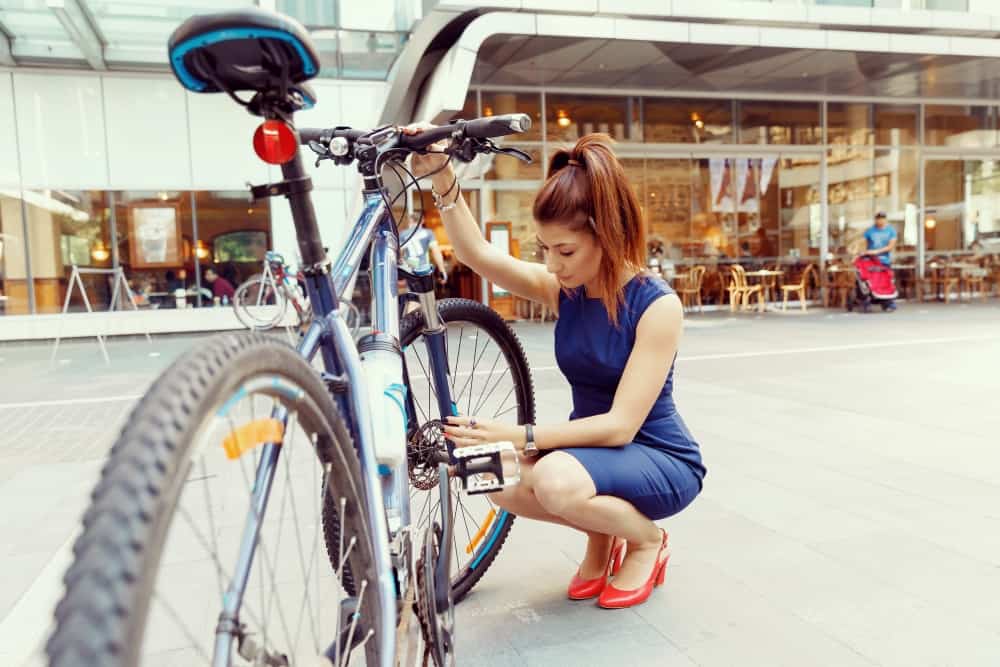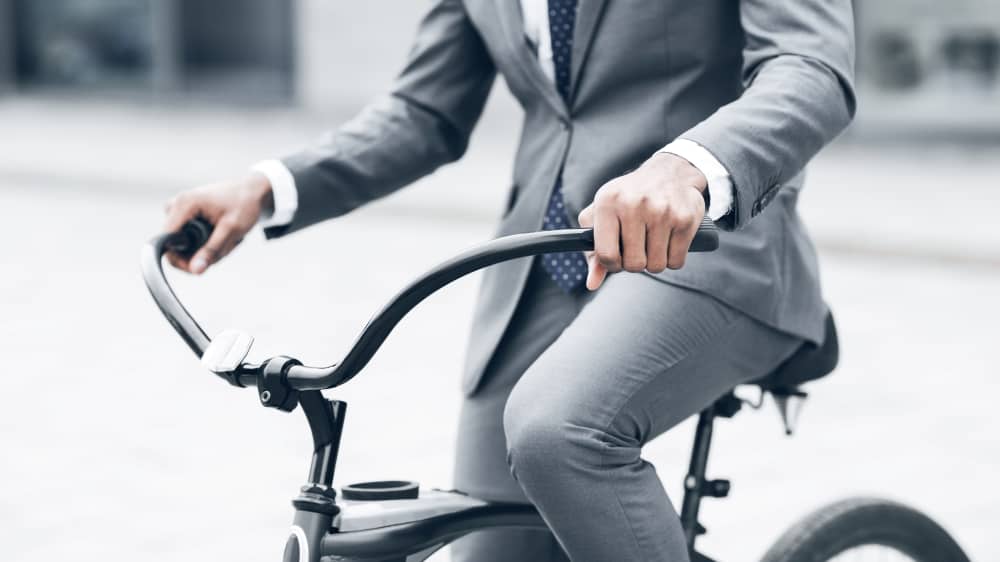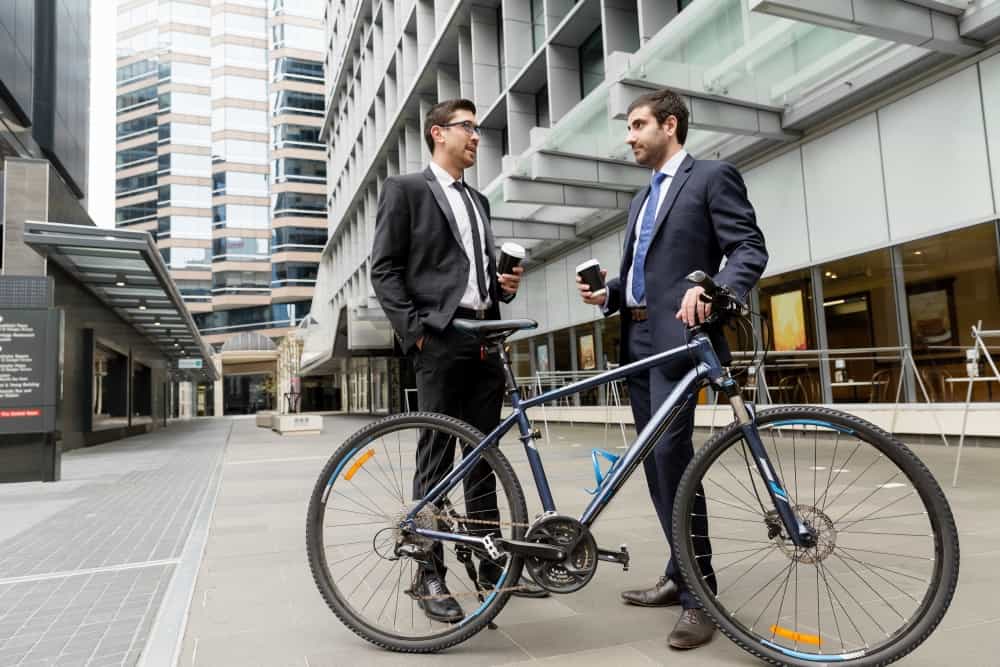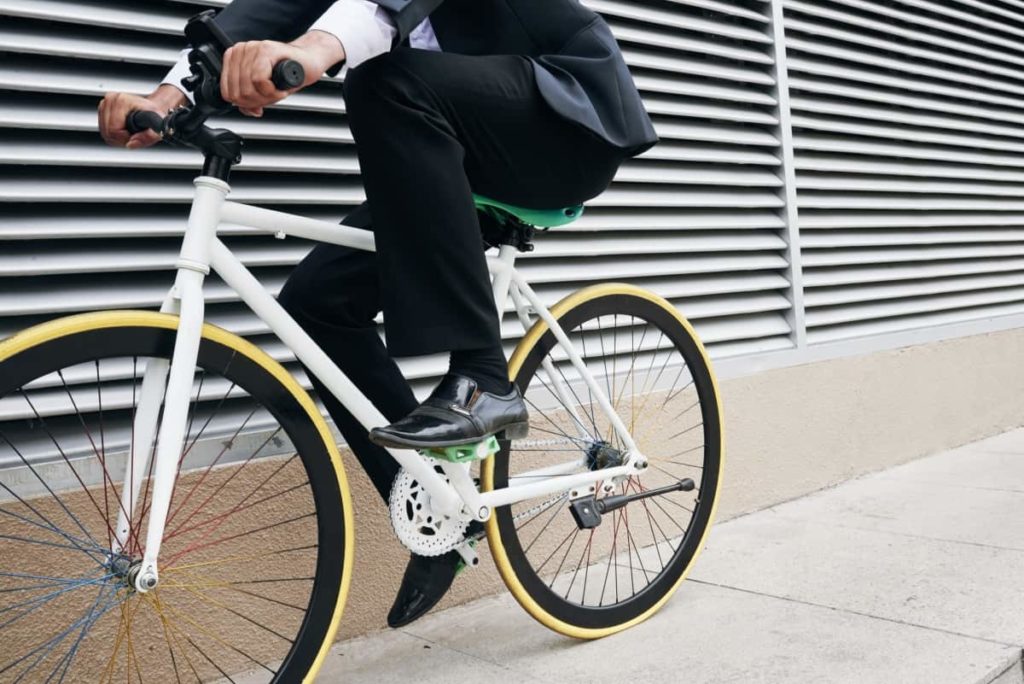Given the number of people who bought bicycles during the pandemic, it’ll be a miracle if anyone ever walks on two legs again.
Once just a vehicle for environmental do-gooders and exercise nuts, the bike is now fast becoming everyone’s favourite transport of choice and commuting to work by bike is set to take the world by storm once everyone’s back in the office
And why the hell not? It’s good for you… the planet… and it can even be a faster journey if you’re used to spending your mornings stuck in traffic.
Yes… where once you used to sneer at the office boffins who strode into work in ridiculous lycra and a silly helmet… now you’re actually thinking of joining them.
But commuting to work by bike is no walk in the park (literally) and before you take the plunge, you’ll need to make sure you’re ready to take on the cycle to work initiative.
So to help you prepare those pins – we’ve put together this beginner’s guide to commuting by bike, helping you shake off any hesitations and join the masses!
Commuting By Bike Tips & Considerations

Checking Your Bike Over
Before you set off cycling to work every day, you first need to survey those old rusty wheels in the garage and check they’ve still got what it takes to conquer the commute.
Because even if an old bike remains robust and isn’t suffering from any faults, you’ll still need to analyse whether it fits the bill for what you’re after.
Some commuters opt for a foldable bike, as they are a fantastically portable option for intercity workers, allowing them to quickly switch from bike to walking speed in a minute. They also give you flexibility should you still want to include public transport in your journey, as they always fold down to a neat, easily stored package.
Another increasingly popular choice for commuters looking to save time is the e-bike, as it’s a speedier alternative to walking that skips road-rage inducing traffic. However, it’s not a great pick for those who still want to reap the rewards of some additional exercise.
The most common bikes you’re likely to already own though are of course either a road racing bike or an all-purpose hybrid bike. Both are fine for commuting, but hybrids will provide an easier ride in hillier areas
Which type of bike best suits you need is up to you, so be sure to consider the terrain your route entails!
Determining The Distance
First off, you need to figure out how achievable a commute to work by bike actually is for you.
Using Google Maps or cycle planning apps, plot your distance from home to work and look for the fastest possible route first.
Once you know the average cycle time, you then need to weigh up why you’re cycling to work – is it to save the planet? Get some exercise in? Or just save time by avoiding traffic issues?
If one of the first two, route times shouldn’t be too much of an issue provided it’s no more than around 45-60 minutes, as riding for any longer may be too tiresome, especially if a beginner.
If you’re cycling to merely save time, then a 45-60 minute bike ride may be completely futile if that’s longer than what it takes you in a car or by bus/train.
If you can’t manage a good time frame and still want to incorporate cycling into your journey somehow, perhaps consider purchasing a folding bike and splitting up your journey into a half-commute on public transport and the other half by bike?
Don’t Overestimate Your Fitness
For those new to cycling, we should really warn you not to overestimate your fitness.
A 30-minute bike ride might not sound like a hardcore distance, but if you go from no exercise ever to a 30-minute bike ride every day, your thighs will probably feel like you’ve been squatting mountain lions by Tuesday afternoon.
Remember that there’s no rush to become a commuting king or queen right from the off and there’s no shame in choosing a certain frequency at first.
Perhaps start by just commuting one day a week, before upping it to two with a few days recovery in between. Eventually, you’ll build up a level of fitness that will allow you to tackle the commute every day.
So when starting out try and remember – this isn’t a race, it’s your commute.
Give Yourself Time
Switching to cycling helps commuters avoid all the stress and annoyance that comes with daily traffic jams, saving you lots of time in the mornings.
However, that’s no excuse to snatch yourself an extra hour in bed and it’s probably wise to still give yourself a 15-minute window of time by setting off slightly early.
This means you can take the ride at a leisurely pace and not be forced to perform any Mark Cavendish-style sprints if you suddenly realise you’re running late.
You don’t want to be rushed or be panicked as this causes carelessness and the extra effort required will also increase the likelihood of you working up a serious sweat!

Finding The Right Gear
Too many commuters spend their cycling budgets on buying ridiculously fashionable outfits and pointless gear that doesn’t really matter for what it is quite simply a quicker trip to work.
Instead, you need to focus on putting your money into gear that really does matter, ensuring you are safe on the roads and presentable at the start of your working day.
First up, it’s helmets. Before you buy anything you need to find yourself a secure, well-fitting helmet that provides plenty of protection. It might mess up your hair, but that’s a damn sight better than a bad crash messing up your skull.
Second, a bell, ideal for signalling to pedestrians that you’re there and want to pass them.
Then to protect your presentability, you may want to invest in some mudguards to prevent mucky lower legs and feet, while waterproof jackets and trousers can also be a good investment to protect from rubbish weather.
It might seem daft, but another really important thing to consider is lights. While you might picture yourself riding early in the morning, winter weather brings darker light and darker nights, where having bike lights will be crucial for your safety.
Don’t be afraid to switch them on in the day either if it improves your visibility!
Don’t Spend A Fortune
If you’re planning on commuting by bike purely to speed up a 10-minute section of your commute, there’s no point kitting yourself up to look like a Tour De France winner.
While longer journeys probably require more specialist gear, lighter commutes could probably be completed in work gear without you even breaking a sweat.
If you don’t plan on cycling leisurely when not commuting you also don’t have to spend a fortune on a commuter’s bike, as your merely using it as a tool to get from A to B, not win a time trail with.
Practice Makes Perfect!
While a GPS app might give you a rough idea of your timings, it can’t precisely work out how fast and efficient a cyclist you are.
So before you try it out on a manic Monday, we suggest first giving your commute route a dry run on the weekend, so you have an even better idea of how much time you have to play with.
Create Safe Routes
Even if it sacrifices some time, beginner cyclists or those not used to commuting should at first try and avoid busy roads and areas with lots of pedestrians or traffic.
This will make your journey altogether less stressful and will ensure you can go at your own pace, with fewer situations and mishaps to adapt to.
Even if finding a super safe route makes your journey slightly longer, as long as it’s not a ridiculous add-on to your timings – it may end up being just as quick as a shorter, road-heavy route – as there’ll be no traffic to account for!
Practice Being A Good Cyclist
When we say you should practice being a good cyclist, we don’t mean you need to start whipping out bunny hops and no handers or train for the next Olympics.
Instead, we refer to learning the rules of the road and becoming a good communicator with traffic and pedestrians, so you can alert others to your movements and keep everyone safe.
While we obviously suggest using cycle lanes and routes as much as possible, it’s inevitable many folks will end up on the road for certain sections of their route, so being clear and decisive in your cycling is important – just like if you were behind the wheel of a car!
Use obvious hand signals to show your direction and be sure to try and gage eye contact with certain drivers – if they don’t return your gaze, always assume they haven’t spotted you and react as needed!
The relationship between cyclists and drivers is still a somewhat fractured one from time to time, so also make sure you’re doing all you can to reinforce better stereotypes by waving and thanking drivers try and help you and avoid getting into any confrontations.
Road Riding Tips
Again, while navigating roads is something you’ll probably want to limit if commuting by bike for the first time, it’s still good to pick up some tips if some become an inevitable section of your route.
While there is often a temptation to tuck in as much as physically possible, be wary that riding too close to the curb or parked cars also has its risks. Always assume a parked car door could suddenly swing open and watch out for gutters, potholes and debris which might potentially pop your tyres or cause you to fall off your bike.
Tucking too far in might also fool drivers behind you into thinking they can perform rash and careless overtakes, so try and find a sweet spot between the curb and oncoming traffic, and stick to cycle lanes where available.
The main thing to worry about when road riding is driver blind spots, as for your own safety you should always want to make yourself known to a car in front of you.
If possible, only overtake on the driver’s vehicle and if forced to go on the opposite side be aware of any upcoming turns which might cut you off and cause an accident.
For beginner commuters, it might be wisest to just not seek overtakes at all if it’s something you’re not comfortable with and bigger vehicles like lorries and buses should definitely be avoided as they boast very large blindspots!
Bike Storage
Although bikes are a lot easier to store away than cars, you still need to make sure there are areas around your place of work where you can safely place them.
If leaving your bike outside, make sure you have purchased a quality bike lock that can securely fasten the bike to a rack or railing.
If you have a folding bike, you’ll be more easily able to store your bike inside your office building – just be sure you have permission and can find an ideal spot, as you’re colleagues probably won’t enjoy tripping over some spokes in the supply cupboard.

Change Of Clothes
Cycling in a suit isn’t really ideal if you’ve plotted out an intensive 45-minute commute, so for longer journeys your best of donning some cycling gear and changing clothes once you get to work!
Strategizing For Hygiene
If any form of exercise makes you break out into a sopping wet sweaty mess, a cycle to work initiative might seem like a bit of a nightmare.
These days though, many office buildings are fully aware of the versatility their employees require, so be sure to check if your place of work boasts on-site showering. To help you dry off after your morning session, be sure to also invest in a chamois towel, a small-sized option which won’t take up all the room in your bag
If your place of work doesn’t have shower facilities, things can become admittedly a little ickier for sweatier cyclists, but there’s nothing stopping you from having a wee birdbath with cloth and soap in the restroom.
Alternatively, if you usually commute via public transport, you could bus/train in on the morning and cycle home on an evening, helping you get a dose of exercise without stinking out the office!
Prepare For Difficulties & Emergencies
Cycling is not always smooth sailing, so we’d always suggest having a few backup gadgets in your work bag to help you out when things go awry, such as a bike pump and a few Allen keys.
It’s also a good idea to have your phone handy in case you need to ring in an emergency or a pal needs to come pick you up should your bike suffer a mechanical failure beyond your expertise.
However, that’s not us giving you an excuse not to know your stuff, so if the idea of solving a flat bike tyre is foreign to you – make sure you get clued up before you begin commuting by bike!



